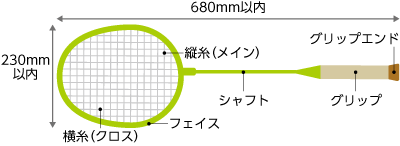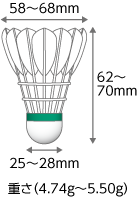SPORTS YOKOHAMA Vol.40 : Feature(1/3)

Badminton holds the Guinness Book record for the fastest initial projectile speed of all racket sports.
The initial speed of a smash can reach up to almost 500 km per hour. Since the shuttlecock decelerates rapidly due to air resistance before reaching the opponent’s court, there is a wide gap between the initial and final speeds – a characteristic not found in other racket sports.
Badminton is played with rackets and a shuttlecock in a relatively small space, and this has made it increasingly popular in recent years as a leisure activity and a lifetime sport that people can enjoy at their own levels.
Read this volume of Sports Yokohama and try badminton!
Research cooperation from: Kumiko Ogura, Gumisawa Badminton Club, Yokohama Hakusan Junior Sports Club, Yokohama Senior High School, Nippon Sport Science University, Yokohama Badminton Association, Yokohama Ladies Badminton Federation, Ochiai Corporation and Sumitomofudosan Esforta
Information provided by: Takayuki Ochiai and Miharu Usui
Photos provided and article written by: Koji Nakamura (Yokohama Sports Association)
History of the sport in Japan
The sport of badminton, born in England, was introduced to Japan around 1921, presumably at Yokohama YMCA. Mr. Herbert Snade, an honorary director of Yokohama YMCA, donated a set of badminton equipment to Mr. Kanetoshi Hirota, who served as the sport director of the association at the time. Mr. Hirota visited sports clubs run by Westerners in Yokohama to acquire physical training skills and was introduced to the game of badminton during those visits. So it is fair to say that his encounter with badminton represented the start of the spread of the sport in Japan (source: Japanese Olympic Committee’s introduction to badminton).
Rules
Badminton is played by either two opposing players (singles) or two opposing pairs (doubles). The basic rules are the same for both types of game. A match is the best of three games, and the player or pair winning two games first wins the match. If the opposing players or pairs have the score tied at 1-1 after the first two games, they play the third (final) game. To win a game, the player or pair must score 21 points.
If the score reaches 20-all, the game goes into extra time and continues until one side gains a two-point lead. In cases where the game continues without either side getting a two-point lead, the player or pair scoring 30 points first wins the match. So the largest possible winning score is 30-29. In the present game of badminton, a rally point system is adopted whereby players score a point whenever they win a rally regardless of whether they served.
Racket
The size of the racket is limited to not more than 680 mm in length and not more than 230 mm in width. Wooden rackets were mostly used in the past while, nowadays, many rackets are composed of carbon fiber composite, with some made of titanium or aluminum. A racket has strings, which are made of chemical fiber such as nylon, and in some cases, titanium is added to the material.
The grip is a wooden handle wrapped with synthetic leather tape.

Shuttlecock
The shuttlecock has a rule requiring that it have 16 feathers embedded into its base. The feathers must each measure 62 to 70 mm from top to bottom and be all identical in length. The tips of the feathers must be arranged in a circular form that is 58 to 68 mm across. The base must be 25 to 28 mm in diameter and have a round bottom. The weight of the shuttlecock is limited to 4.74 to 5.50 grams. There are two types of shuttlecock: one made of natural materials and the other made of synthetic materials. Widely used natural materials are goose feathers, duck feathers and a combination of both. Shuttlecocks typically used in competitions are composed of goose feathers, while less expensive duck feather shuttlecocks are used for training purposes.


Badminton holds the Guinness Book record for the fastest initial projectile speed of all racket sports.
The initial speed of a smash can reach up to almost 500 km per hour. Since the shuttlecock decelerates rapidly due to air resistance before reaching the opponent’s court, there is a wide gap between the initial and final speeds – a characteristic not found in other racket sports.
Badminton is played with rackets and a shuttlecock in a relatively small space, and this has made it increasingly popular in recent years as a leisure activity and a lifetime sport that people can enjoy at their own levels.
Read this volume of Sports Yokohama and try badminton!
Research cooperation from: Kumiko Ogura, Gumisawa Badminton Club, Yokohama Hakusan Junior Sports Club, Yokohama Senior High School, Nippon Sport Science University, Yokohama Badminton Association, Yokohama Ladies Badminton Federation, Ochiai Corporation and Sumitomofudosan Esforta
Information provided by: Takayuki Ochiai and Miharu Usui
Photos provided and article written by: Koji Nakamura (Yokohama Sports Association)
History of the sport in Japan
The sport of badminton, born in England, was introduced to Japan around 1921, presumably at Yokohama YMCA. Mr. Herbert Snade, an honorary director of Yokohama YMCA, donated a set of badminton equipment to Mr. Kanetoshi Hirota, who served as the sport director of the association at the time. Mr. Hirota visited sports clubs run by Westerners in Yokohama to acquire physical training skills and was introduced to the game of badminton during those visits. So it is fair to say that his encounter with badminton represented the start of the spread of the sport in Japan (source: Japanese Olympic Committee’s introduction to badminton).
Rules
Badminton is played by either two opposing players (singles) or two opposing pairs (doubles). The basic rules are the same for both types of game. A match is the best of three games, and the player or pair winning two games first wins the match. If the opposing players or pairs have the score tied at 1-1 after the first two games, they play the third (final) game. To win a game, the player or pair must score 21 points.
If the score reaches 20-all, the game goes into extra time and continues until one side gains a two-point lead. In cases where the game continues without either side getting a two-point lead, the player or pair scoring 30 points first wins the match. So the largest possible winning score is 30-29. In the present game of badminton, a rally point system is adopted whereby players score a point whenever they win a rally regardless of whether they served.
Racket
The size of the racket is limited to not more than 680 mm in length and not more than 230 mm in width. Wooden rackets were mostly used in the past while, nowadays, many rackets are composed of carbon fiber composite, with some made of titanium or aluminum. A racket has strings, which are made of chemical fiber such as nylon, and in some cases, titanium is added to the material.
The grip is a wooden handle wrapped with synthetic leather tape.

Shuttlecock
The shuttlecock has a rule requiring that it have 16 feathers embedded into its base. The feathers must each measure 62 to 70 mm from top to bottom and be all identical in length. The tips of the feathers must be arranged in a circular form that is 58 to 68 mm across. The base must be 25 to 28 mm in diameter and have a round bottom. The weight of the shuttlecock is limited to 4.74 to 5.50 grams. There are two types of shuttlecock: one made of natural materials and the other made of synthetic materials. Widely used natural materials are goose feathers, duck feathers and a combination of both. Shuttlecocks typically used in competitions are composed of goose feathers, while less expensive duck feather shuttlecocks are used for training purposes.

 ハマスポ
ハマスポ
 お知らせ&トピックス
お知らせ&トピックス
 ページトップへ戻る
ページトップへ戻る ページトップへ戻る
ページトップへ戻る

